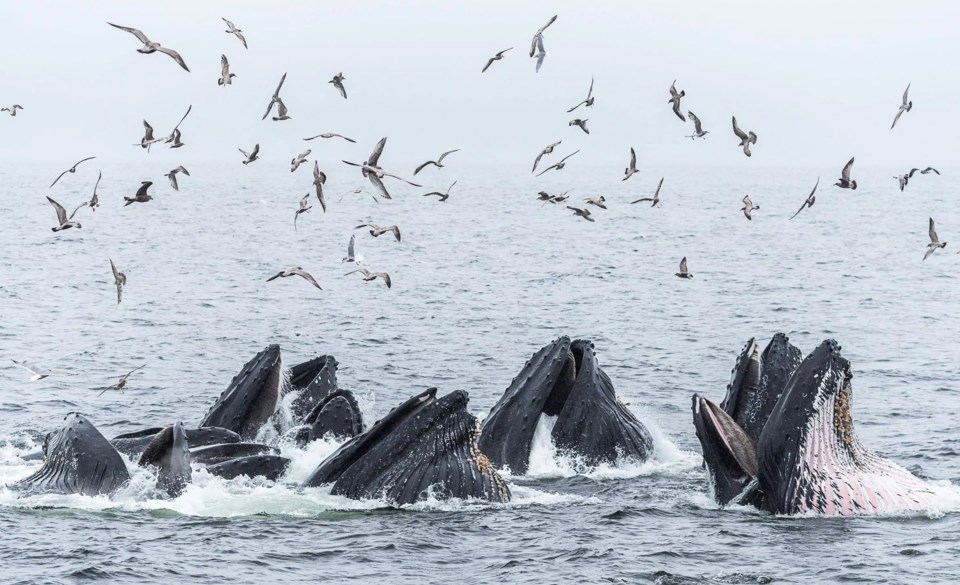For the Gitga’at Nation, Douglas Channel on the B.C.’s north coast is more than a shipping lane — it’s also a haven for at-risk humpback and fin whales.
Now, a new wave of shipping traffic to the LNG Canada project in Kitimat means the whales must navigate the threat of deadly ship strikes and the din of underwater noise in formerly quiet waters.
Once wiped out from Gitga’at waters by commercial whaling, baleen whales such as humpbacks and fin whales have made a remarkable comeback over the past two decades in the Kitimat fjord system, said Kyle Clifton, acting director of Gitga’at Oceans and Lands Department.
Now the area is home to the highest density of humpback and fin whales on the coast, while also being important to northern resident and transient killer whales.
“The whale activity I’ve seen change in my lifetime is actually pretty crazy,” said Clifton, who spent his youth on the water in the '80s and '90s as a commercial fisher.
“I can think of a couple of times we saw them [while] working in the territory. Now it’s weird to go out in the boat and not see whales,” he said.
The whales may have returned in unusual numbers because they enjoyed a relatively tranquil environment in the region’s inlets and channels, which are also rich in food, said Grace Baer, research and project manager for North Coast Cetacean Society (BC Whales).
Whales and tankers on collision course
Super tankers began travel to LNG Canada in Kitimat on shipping routes that heavily overlap with at-risk whale hotspots starting in June.
But this is the first year LNG tankers have begun to ply Douglas Channel, said Baer, who visually and acoustically monitors the whales in the waters surrounding Fin Island located near the entrance of the inlet.
In past years, approximately 50 large vessels visited Kitimat each year. That number is expected to grow to 170 ships annually in the next two years. Once phase two of LNG Canada and the smaller Cedar LNG project are finished, at least one — if not two — tankers will come and go daily along shipping routes that heavily overlap with key humpback and fin whale habitat, said Baer.
“We’ve documented whales feeding, resting, and socializing in the very same areas LNG tankers will be travelling,” she said.
Whale song in formerly silent waters now must contend with the deafening churn of LNG tankers that creates an “acoustic fog,” hindering the animals’ ability to find food, care for offspring or communicate with one another, she said.
An LNG tanker can significantly degrade the underwater soundscape and disrupt whales’ critical life processes for upwards of 40 minutes depending on where the ships and animals are located, she said. Humpbacks and fin whales are also highly vulnerable to ship strikes due to their tendency to rest or feed at the surface, Baer said.
The whales, which don’t have prominent dorsal fins like killer whales, are hard to spot, can surface unexpectedly and resemble logs when lounging in the water, Clifton said. Once while travelling in a small boat with his family, Clifton said he had to slow suddenly to avoid a humpback at the surface. The whale dove and resurfaced behind the boat.
“Sure enough, he comes up behind the boat trumpeting and grumpy, like he’s saying ‘watch where the hell you’re going,’” Clifton said. “Things like that can happen. So, it's of great concern for the Gitga’at to make sure whales are monitored so we don’t have incidents or ship strikes.”
The Gitga’at, BC Whales and WWF Canada are collaborating on an acoustic monitoring project called SWAG that uses AI and high-tech hydrophones to locate whales in real time in a bid to manage shipping threats.
Sound and strikes a lethal combo
A humpback named Moon was documented by the BC Whales research group in Sept. 2022 in northern B.C. waters with a severe injury to her spine likely caused by a vessel strike.
Those threats are significant, said Hussein Alidina, marine conservation lead for WWF Canada, who noted whale strikes along with entanglement in fishing gear are top threats to humpbacks and fin whales.
When fully operational, LNG shipping traffic is expected to cause the death of two fin whales and 18 humpbacks each year over the 40-year life span of the project, research suggests. This rate will deplete both whale populations in coastal B.C., Alidina said.
Transport Canada, the Gitga’at and LNG Canada have worked to establish voluntary slow-downs for all large vessels to 10 knots in seasonal whale hotspots from July to October.
LNG Canada is taking a further step and extending the 8 to 10 knot speed limit year-round in areas of high whale activity, Teresa Waddington, deputy chief operating officer, said in an email, adding reduced speeds are considered the most effective way to lower the threat of noise pollution and collision.
Whale awareness guides have been created for ship crews traversing the channel and LNG tanker crews and the experienced BC coastal pilots required on vessels will keep a lookout to increase detection, according to LNG Canada.
Regulatory blind spots
Visual lookouts won’t do much good in the dark, said Baer, noting several tankers have visited LNG Canada in the middle of the night.
“The scary thing, of course, is that we couldn't see if there were whales in front of them, and they had no opportunity to know if there were any there, either,” she said.
Humpback and fin whales are extra vulnerable at night because they tend to spend more time at the surface— especially when they are feeding on krill, small shrimp-like creatures that migrate upwards in the ocean when it's dark and descend to the deep when it's light, she said.
Neither LNG Canada nor Transport Canada or DFO responded to questions from Canada’s National Observer about whether any additional measures, such as limiting tanker visits to daylight hours, are planned to reduce the dangers of whale strikes or noise pollution.
Vessel slow-downs, which are left to the discretion of onboard pilots, are insufficient to mitigate the threat of whale strikes and underwater noise pollution, Alidina said. Additionally, there are no maximum thresholds for underwater noise in the channel, and no requirements for the LNG tankers to meet certain “quiet ship” classifications — where vessels are ranked by how much noise pollution they produce.
There’s no public transparency around the reporting of vessel strikes nor adequate regulatory oversight by the transport ministry or Oceans and Fisheries, Alidina said.
LNG Canada also hasn’t done any current baseline research about whale behaviour and habitat, which makes it impossible to properly assess the impacts now vessel traffic has begun, he added. What’s more the company’s whale survey, trial with infrared cameras to detect whales and noise verification study will take place in two years — when shipping tied to phase one of the project is expected to peak, according to LNG Canada’s marine mammal management and monitoring plan.
Transport Canada and DFO have a rare opportunity to get ahead of the impending surge in shipping traffic and potential lethal impacts to whales — particularly the area’s unique fin whale population — and prevent Douglas Channel from suffering unsustainable levels of pollution, noise and traffic like in southern B.C.’s Salish Sea, he said.
From recovery to risk
Baer agreed, noting the whale populations have enjoyed “sanctuary-like” conditions in the region for upwards of two decades.
“All of a sudden their world has changed, and they don't know it in the same ways that we do,” she said. “It's really difficult to watch as they don't know what's coming towards them.”
LNG Canada must report whale strikes and other vessel monitoring measures to the Gitga’at, who have a direct line of communication to raise concerns with the company about shipping issues, Clifton said. Guardians patrolling the nation’s territorial waters can also alert incoming ships about whale activity in the region.
The nation is benefiting from some of the economic activities tied to the project, but wants to ensure the whales get the protections they need, he said.
“It makes you happy that something that big is able to enjoy your territory just like you do,” he said, noting it’s in LNG Canada’s interests to mitigate shipping impacts on whales.
“They want positive news stories coming out about their project,” he said.
“If your ship shows up in Kitimat with a fin whale on the bow, like has happened in other places, then that’s not going to look good.”




